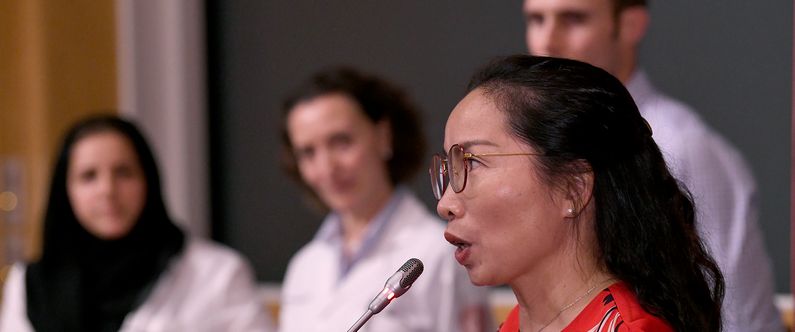Students explore world of complementary and alternative medicines
 Dr. Ai Honglan, acupuncture expert with the Qatar Armed Forces Military Medical Specialty Center gives her lecture.
Dr. Ai Honglan, acupuncture expert with the Qatar Armed Forces Military Medical Specialty Center gives her lecture.
First-year medical students had the chance to learn about three complementary and alternative medicines (CAM) when a chiropractor, an acupuncturist and a homeopath visited WCM-Q to give presentations about their disciplines.
Students crowded into Lecture Hall 1 to hear the presentations by Dr. Ai Honglan, acupuncture expert with the Qatar Armed Forces Military Medical Specialty Center, Chiropractor Dr. Matthys Le Roux of the International Physiotherapy Centre in Doha, and Ms. Niloofar Rezai, a homeopathic consultant. The lecture was part of the Essential Principals of Medicine (EPOM) course.
Dr. Ai said that acupuncture is used to treat a range of conditions, including musculoskeletal diseases, such as pain in the muscles and joints, herniated discs, fasciitis, tendinitis and spondylosis. Acupuncture is also used to treat neurological conditions, such as Bell’s palsy, headaches and migraines, as well as digestive diseases, diseases of the ear, nose and throat, and even fertility issues. Treatments include insertion of steel needles into the skin, fire cupping and wet cupping (using cups to create suction on the skin) and fire needling (quickly inserting and withdrawing a red-hot needle).

Dr. Ai said: “Acupuncture is a key component of TCM – traditional Chinese medicine. It is a treatment that encourages the body to promote natural healing and improve function. The essence of acupuncture is microinjury, which causes increased blood-flow to the area and brings healing to the area.”
Dr. Le Roux said that chiropractic is most commonly used to treat pain in the back, neck, shoulders and extremities, as well as related issues like tension headaches and migraines, and underlying conditions causing joint pain, like arthritis. Chiropractic courses last for four to six years, and students study many of the same subjects as medical students but begin to specialize much earlier, he said. The treatment is primarily based on manipulation of the spine and joints to improve mobility and promote self-healing.
He said: “The philosophy is that the body is a self-regulating organism, so there is a big focus on spinal manipulative therapy and the manipulation of specific joints to restore mobility and allow the body to heal itself. These are very specific, high velocity, low amplitude manipulations delivered to a specific articulation.”
Ms. Rezai said that homeopathy focuses on treating the whole patient rather than just the specific ailment. She explained that homeopathic medicines are made by taking natural ingredients, such as onion, and agitating them in water in very low concentrations. The end product is then placed onto a carrier substance – usually a small pill of sugar – and given to the patient to take orally.
First-year student Mai AlSubaie said: “It was very good to learn more about complementary and alternative medicine approaches because when we become doctors, we will have patients who use them, so we need to understand them. I found them fascinating, especially homeopathy, which I knew very little about.”
Dr. Stella Major said: “As physicians it is extremely important to have a good working knowledge of complementary and alternative medicine in order to be able to speak confidently with patients who may use them and provide sensible advice. I was therefore very pleased that the students were open-minded and engaged with the CAM practitioners, and I feel they got a great deal from the learning experience.”
